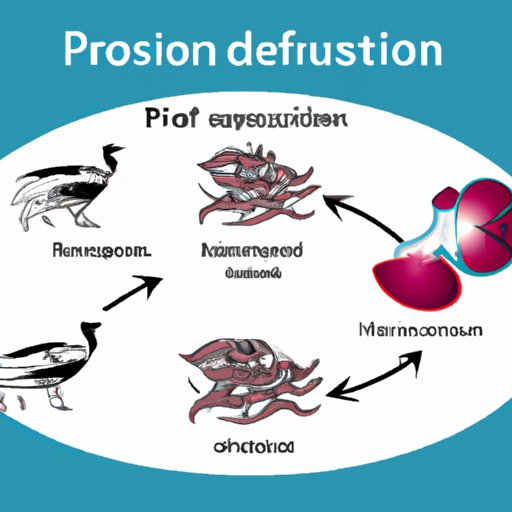
I. Introduction
Prion diseases, also known as transmissible spongiform encephalopathies, refer to a group of rare but deadly neurodegenerative diseases that affect both animals and humans. Examples of prion diseases include mad cow disease, Creutzfeldt-Jakob disease, and kuru, among others. Although prion diseases are rare, they are difficult to diagnose and currently have no cure. Therefore, understanding the causes, mechanisms, and possible prevention measures for prion diseases is of utmost importance.
This article aims to provide a comprehensive guide to understanding prion diseases, including their causes, mechanisms, past outbreaks, as well as current research and treatment options. It is a useful resource for anyone interested in learning more about prion diseases, including healthcare professionals, policymakers, and the general public.
II. A Comprehensive Guide to Understanding Prion Disease-Causing Agents and their Mode of Action
A. Definition of prions
Prions are unique infectious agents that are made up of abnormal proteins that can fold and change the structure of normal proteins. Prions are resistant to traditional sterilization methods such as heat and radiation, making them difficult to eliminate. The accumulation of abnormal prion proteins in the brain causes neurodegeneration and eventually leads to death.
B. Explanation of how prions cause disease
Prions cause disease by converting normal proteins into abnormal prions. The abnormal prions then accumulate in the brain, forming clumps and destroying brain cells. This accumulation of abnormal prion proteins in the brain leads to the characteristic symptoms of prion diseases such as dementia, loss of coordination, and eventually death.
C. Types of prion diseases
There are several types of prion diseases, including:
- Creutzfeldt-Jakob disease (CJD)
- Kuru
- Variant Creutzfeldt-Jakob disease (vCJD)
- Gertsmann-Straussler-Scheinker Syndrome
- Fatal Familial Insomnia
- Chronic Wasting Disease (CWD)
- Mad Cow Disease (Bovine Spongiform Encephalopathy)
D. Sources of prion disease-causing agents
Prion diseases can be caused by genetic mutations, sporadic events, or exposure to contaminated materials. For example, mad cow disease was caused by cows being fed animal parts contaminated with abnormal prion proteins. In humans, prion diseases can be caused by consuming contaminated meat or exposure to contaminated surgical instruments.
III. The Science Behind Prion Diseases: Biological Mechanisms and Genetic Factors
A. Overview of the biology of prion diseases
Prion diseases are unique in that they can be caused by both genetic mutations and exposure to contaminated materials. The abnormal prion proteins that cause prion diseases cannot be detected by the immune system, making them difficult to diagnose. The accumulation of abnormal prion proteins in the brain leads to neurodegeneration, but the exact mechanism of how this occurs is still not fully understood.
B. Explanation of genetic factors that contribute to prion disease
Some prion diseases, such as Fatal Familial Insomnia and Gertsmann-Straussler-Scheinker Syndrome, are caused by genetic mutations. These mutations cause the body to produce abnormal prion proteins, leading to neurodegeneration and eventually death. Genetic testing can be performed to determine if someone is at risk of developing these genetic prion diseases.
C. Environmental factors that increase risk
Exposure to contaminated materials, such as infected meat or surgical instruments, can increase the risk of developing prion diseases. However, it is important to note that the risk of developing prion diseases from these exposures is low.
IV. A Detailed Analysis of the Outbreaks of Prion Diseases in the Past: Lessons Learned and Possibilities for Prevention
A. Overview of past outbreaks of prion diseases
Past outbreaks of prion diseases have had a significant impact on public health. For example, the mad cow disease outbreak in the 1990s resulted in the slaughter of millions of cattle and the implementation of stricter regulations on animal feed. Similarly, the outbreak of variant Creutzfeldt-Jakob disease in humans was linked to the consumption of contaminated meat and resulted in changes to food safety regulations.
B. Discussion on the lessons learned from these outbreaks
The past outbreaks of prion diseases have taught us the importance of surveillance, early detection, and prevention measures. These outbreaks have also highlighted the need for stricter regulations on animal feed and food safety in general.
C. Brief explanation on prevention and control measures
Prevention and control measures for prion diseases include strict animal feed regulations, proper sterilization of medical equipment, and early detection and surveillance systems. These measures are important for reducing the risk of prion diseases and preventing future outbreaks.

V. Examining the Role of Prion Disease in the Global Public Health Pandemic
A. Explanation of the global impact of prion diseases
Prion diseases are relatively rare, but they have a significant impact on global public health due to their high mortality rate and long incubation period. In addition, the potential for prion diseases to become pandemic is a concern.
B. Discussion on trends in the spread of prion diseases worldwide
The spread of prion diseases worldwide is primarily due to the movement of contaminated materials, such as animal feed and medical equipment. The ease of global travel also increases the risk of prion diseases spreading between countries.
C. Possible implications for the future
The potential for prion diseases to become pandemic is a concern, and it highlights the need for improved prevention and control measures. Early detection and surveillance systems are important for reducing the spread of prion diseases.
VI. Rare but Deadly: Exploring the Epidemiology and Transmission Pathways of Prion Diseases
A. Overview of the epidemiology of prion diseases
Prion diseases are rare, but their high mortality rate makes them a concern. The long incubation period of prion diseases also makes them difficult to detect and control.
B. Description of common transmission pathways
Common transmission pathways for prion diseases include consumption of contaminated meat or exposure to contaminated medical equipment.
C. Explanation of rare transmission pathways
Rare transmission pathways for prion diseases include vertical transmission from mother to offspring, blood transfusions, and surgical implants.
VII. Myths and Misconceptions about Prion Diseases: Debunking the Most Common Misconceptions
A. Overview of common misconceptions about prion diseases
Common misconceptions about prion diseases include the belief that they can be cured with antibiotics or that they are easily transmitted from person to person. These misconceptions are not based on scientific evidence.
B. Explanation on why these misconceptions are wrong
Prion diseases cannot be cured with antibiotics because they are not caused by bacteria or viruses. Prion diseases are also not easily transmitted from person to person, as they require exposure to contaminated materials.
C. Clarification on relevant facts
It is important to understand the biological mechanisms and environmental factors that contribute to prion diseases in order to dispel myths and misconceptions.
VIII. Looking to the Future: Advances in Research and Potential Treatments for Prion Diseases
of current research on prion diseases
Current research on prion diseases is focused on developing early detection methods, improving surveillance systems, and identifying potential treatments. There is still much to be learned about prion diseases and their biological mechanisms.
B. Explanation of promising treatment options
There are currently no treatments for prion diseases, but there are several promising treatments being researched. These include vaccines, antibodies, and small molecule drugs.
C. Call to action for continued research
Continued research is essential for understanding and preventing prion diseases. Healthcare professionals, policymakers, and the public should advocate for increased funding and support for prion disease research.
IX. Conclusion
A. Recap of key points
Prion diseases are rare but deadly neurodegenerative diseases that affect both animals and humans. They are caused by abnormal prion proteins that accumulate in the brain and cause neurodegeneration. There are several types of prion diseases, and they can be caused by genetic mutations or exposure to contaminated materials. Prevention and control measures for prion diseases include strict regulations on animal feed, proper sterilization of medical equipment, and early detection and surveillance systems.
B. Call to action for improved prevention and control measures
Improved prevention and control measures for prion diseases are needed to reduce the risk of future outbreaks and prevent the potential for prion diseases to become pandemic. It is important for healthcare professionals, policymakers, and the public to advocate for increased funding and support for prion disease research.
C. Encouragement to spread awareness about prion diseases
Spreading awareness about prion diseases is important for reducing the risk of transmission and improving public health outcomes. Everyone can play a role in raising awareness about prion diseases and promoting prevention and control measures.




